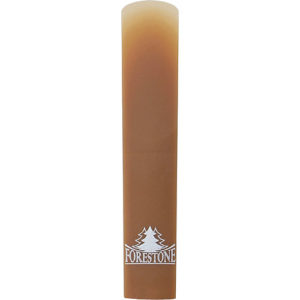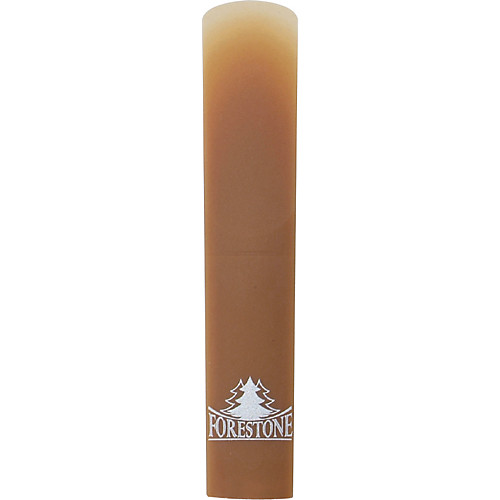 What do you get when you combine 50% bamboo with a soft specially formulated resin? You get a pretty good reed that comes with a pain in the ass caveat. While being a mid priced contender in the synthetic reed category this brand may cost you more initially.
What do you get when you combine 50% bamboo with a soft specially formulated resin? You get a pretty good reed that comes with a pain in the ass caveat. While being a mid priced contender in the synthetic reed category this brand may cost you more initially.
As most sax player who know me can attest, I am a complete convert from natural cane to synthetic and hybrid reeds. The quality of these products have come a long way since the old “Betcha”, Luellen, and Maccaferri plastic reeds from the 1940’s and 50’s. Today we have many more choices than ever before. The most popular brands are: Légère, Forestone, Hartmann Fiberreed, Bravo, Bari, and Fibracell. There are new far east manufacturers launching products nearly monthly so as more players explore synthetics I expect established reed brands like Vandoren will eventually enter the marketplace. Rico entered the specialty reeds market in the 90’s with the black Plasticover reeds. These are simply cane reeds that have been covered with a very thin layer of plastic or resin. Of the popular brands there is a lot to like and dislike but in the end it’s up to each player to try them and decide on their own.
How I judge a reeds performance.
- Tone Quality
- Surface Finish and build quality
- Ease of use
- Longevity
- Cost
Sound Quality: The tone from a properly strength reeds has most of the depth and sweetness of cane. I had a hard time hearing the difference in some low passages during playback of my recordings. The reed has a unique but cane-like sound. The low end of the horn really responds well to these reeds and speak with authority especially the low Bb and A. Most players sitting next to me never hear a difference and for the most part no audience member has noticed anything amiss.
Surface and build quality: This is where some of the highest and lowest priced reeds start to falter. Reeds like Hartmann and the Brave tend to have sharp side rails and tip rails. I’ve more than once given myself a abrasion on my lower lip and tongue using these reeds. The Forestones’ on the other hand are smooth in texture and almost velvety soft. Not literally velvety but softer than the plastic feel of the Légère and Bravo. The side rails and tip are slightly rounded and from the vamp to the tip is nearly glass like in smoothness. Over all it has the best mouth feel of all the reeds, natural and synthetic, that i own.
Ease of Use: This depends on the ligature type, reed strength, mouthpiece table finish but this reed is like most synthetics. You can strap them on and play. There’s no need to warm them up, soak them, or do anything special before playing them. Forestone reeds because of their slightly ‘softer’ material seems to stay where i put it on the mouthpiece without need to crank hard on the ligature. That’s not the case for all synthetics. Some ligatures won’t grip a synthetic firmly enough for some players. That’s a problem I started having with Légère reeds once I moved to my Theo Wanne Durga mouthpiece. The metal tone plate had a hard time keeping the reed from moving let to right. I’ve contacted Légère about adding a texture to the bark of their reeds to compensate and give the ligature a fighting chance to secure the reed without over tightening the ligature.
Longevity: This is where most of us start tying synthetics. The Forestone do not disappoint in this area. Like most synthetics, these reeds can take a ton of abuse that would cripple or break a cane reed. See Derick Brown the BeatBox-Sax on Youtube, he uses Légère exclusively. There aren’t many advanced techniques that will cause harm to these or most synthetics.
I am able to use these for 3 months at a time before they are slightly but noticeably softer. That include using them for 10 – 20 hours a week for rehearsals and gigs. 3 months is a bit less than I get with Légère which i can use for 4 to 6 months before they feel fatigued. Now all is not coming up roses as the Forestone’s change throughout a gig. They start off cold at one strength and then 1.5 hours in it’s about a 1/4 strength softer. I find this happens mostly where the gig has near constant bari parts with minimal cool down between songs.
Cost: These things are cheap compared to a box of reed but expensive if you have to buy a few to find your strength. The average for sing reeds, aside from the Bravo’s, is around $28. This is a little cheaper than a box of Vandoren or Rico Selects.
The Pros:
- consistent performance
- no warm up needed
- no warping
- no water logging
- no humidity, temperature, or altitude problems
- longer life than that of a traditional cane reed
- can be adjusted by clipping or shaving
The Cons: The most egregious of all the issues with these reeds is the strength numbering system. They have two systems floating around, the F1 – 5 and the Soft – Hard system. It could be that they changed from one system to the other but had so much inventory already distributed that it was impractical to recall them or offer the vendors stickers to explain the current system. Either way it’s a pain in the ass and I’ve found that if you can try a few sizes up and down from your normal strength at your local music shop then you’ll save money dialing in your preferred strength.
Take away and the Reality of Synthetics: Like most synthetic reeds these have a particular sound. It’s a sound that is unique to itself and to the player using them. They may get close to sounding like cane but they will never replicate cane perfectly but I’d argue that even cane isn’t consistent enough within a single box let alone across the various brands to have a signature cane sound. Instead of expecting synthetics to sound like cane the player should approach synthetics for their unique sounds and find the one that meets their performance goals and tone concept. I think most people who try and hate synthetics either haven’t tried recent ones or are disappointed that it didn’t sound precisely like that perfect reed from their favorite brand. Instead, if they had approached them as unique tools to develop their signature sound then they would enjoy the experience more.

